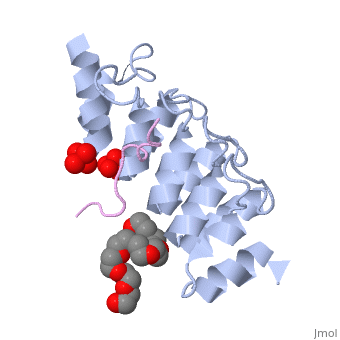3twr
From Proteopedia
Crystal structure of ARC4 from human Tankyrase 2 in complex with peptide from human 3BP2
Structural highlights
Disease[3BP2_HUMAN] Defects in SH3BP2 are the cause of cherubism (CRBM) [MIM:118400]. CRBM is an autosomal dominant inherited syndrome characterized by excessive bone degradation of the upper and lower jaws, which often begins around three years of age. It is followed by development of fibrous tissue masses, which causes a characteristic facial swelling.[1] [2] [3] Function[TNKS2_HUMAN] Poly-ADP-ribosyltransferase involved in various processes such as Wnt signaling pathway, telomere length and vesicle trafficking. Acts as an activator of the Wnt signaling pathway by mediating poly-ADP-ribosylation of AXIN1 and AXIN2, 2 key components of the beta-catenin destruction complex: poly-ADP-ribosylated target proteins are recognized by RNF146, which mediates their ubiquitination and subsequent degradation. Also mediates poly-ADP-ribosylation of BLZF1 and CASC3, followed by recruitment of RNF146 and subsequent ubiquitination. Mediates poly-ADP-ribosylation of TERF1, thereby contributing to the regulation of telomere length. May also regulate vesicle trafficking and modulate the subcellular distribution of SLC2A4/GLUT4-vesicles.[4] [5] [6] [7] [3BP2_HUMAN] Binds differentially to the SH3 domains of certain proteins of signal transduction pathways. Binds to phosphatidylinositols; linking the hemopoietic tyrosine kinase fes to the cytoplasmic membrane in a phosphorylation dependent mechanism. Publication Abstract from PubMedThe poly(ADP-ribose)polymerases Tankyrase 1/2 (TNKS/TNKS2) catalyze the covalent linkage of ADP-ribose polymer chains onto target proteins, regulating their ubiquitylation, stability, and function. Dysregulation of substrate recognition by Tankyrases underlies the human disease cherubism. Tankyrases recruit specific motifs (often called RxxPDG "hexapeptides") in their substrates via an N-terminal region of ankyrin repeats. These ankyrin repeats form five domains termed ankyrin repeat clusters (ARCs), each predicted to bind substrate. Here we report crystal structures of a representative ARC of TNKS2 bound to targeting peptides from six substrates. Using a solution-based peptide library screen, we derive a rule-based consensus for Tankyrase substrates common to four functionally conserved ARCs. This 8-residue consensus allows us to rationalize all known Tankyrase substrates and explains the basis for cherubism-causing mutations in the Tankyrase substrate 3BP2. Structural and sequence information allows us to also predict and validate other Tankyrase targets, including Disc1, Striatin, Fat4, RAD54, BCR, and MERIT40. Structural basis and sequence rules for substrate recognition by tankyrase explain the basis for cherubism disease.,Guettler S, Larose J, Petsalaki E, Gish G, Scotter A, Pawson T, Rottapel R, Sicheri F Cell. 2011 Dec 9;147(6):1340-54. PMID:22153077[8] From MEDLINE®/PubMed®, a database of the U.S. National Library of Medicine. See AlsoReferences
| ||||||||||||||||||||||||||

